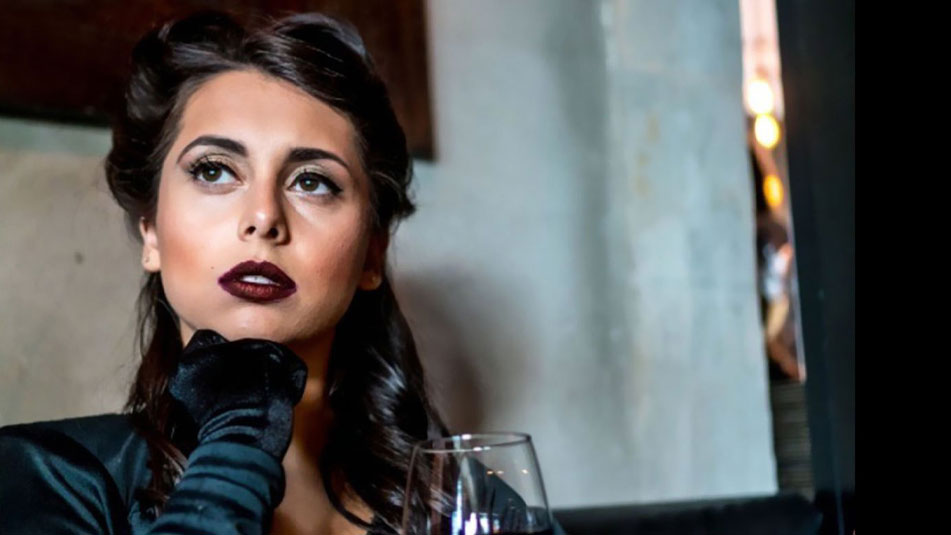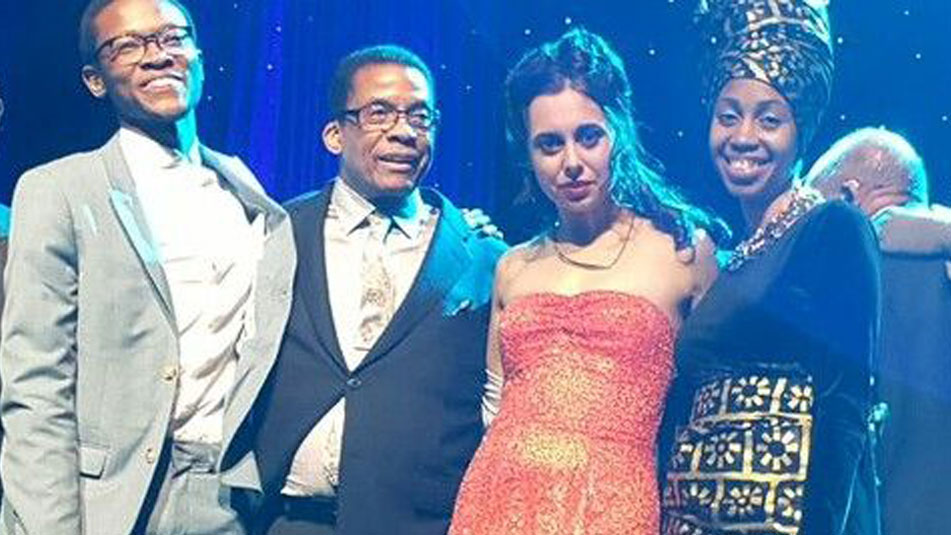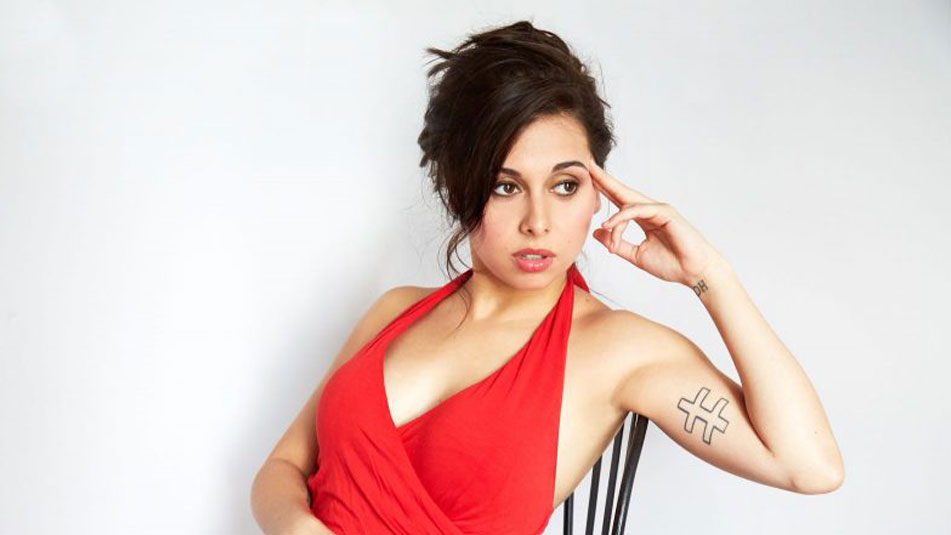Edge and intensity personified:
veronica Swift Interview
August 21, 2019 | by Richard Scheinin

Veronica Swift
Jazz singer Veronica Swift recorded her first album when she was nine, and she can talk a blue streak about life as a creative artist. Music is all-consuming, she says, likening it to an addiction or a religious devotion: “Be ready to not have a life. That’s what I tell my students,” she says. “I’m pretty much always traveling, every day. I’m not knocking my profession. It’s a beautiful life, but it’s a sacrifice.” She puts it another way: “I’m pretty much a musical nun!”
The 25-year-old has long been attracted to opera, rock, metal – music with a “dark edge,” with “intensity” – and she would like to funnel more of the darkness and the intensity into her jazz performances. Confessions, her new album on the Mack Avenue label, focuses on tunes from the American Songbook. But her next recording is likely to include songs by Queen, dropping hints of dark energy into her repertoire: “I believe that every artist should evolve, otherwise, you’re just a musician and not really an artist,” says Swift, who brings her trio — led by pianist Emmet Cohen — to SFJAZZ next month for eight shows over four nights (Sept. 5-8). “You’re living and breathing and moving and having all these experiences, and you should be bringing all that into what you do.” In other words, the whole notion of change as a way of living and creating would seem to come naturally to Swift – but, actually, that’s not the case. “No! I grew up on a farm and I’m from a very stable household,” she says, “and the stories people love are the ones about the orphans and the people who have suffered. But I’m not like that and I am afraid of change. It’s this constant battle and struggle to try to be open to it,” she says, noting that musicians “aren’t always what we seem. We’re actors. We’re speaking from a true place, but we’re acting. I’m not going to go on stage and say, `I’m having a shitty day and fuck off, everybody!’”

Vocalist Vuyo Sotashe, Herbie Hancock, Veronica Swift and vocalist Jazzmeia Horn at the 2015 Monk Competition in Los Angeles
Since finishing second in the 2015 Thelonious Monk Jazz Competition for vocalists – kind of like winning a Silver Medal in the Olympics — Swift’s career has taken off. She is the daughter of singer Stephanie Nakasian (who toured with Jon Hendricks in the ‘80s) and the late pianist Hod O’Brien (whose New York career included stints with Oscar Pettiford, Elvin Jones, Lee Konitz and many others). Swift — it’s her stage name; more on that later – is carrying their torch. The Monk competition finals took place in Los Angeles in November 2015, shortly after terrorist gunmen and suicide bombers massacred audience members at the Bataclan theater in Paris. Hearing the news, Swift set aside the number she had planned to sing – “Darn That Dream,” which she and her father used to play together — and substituted “This Bitter Earth,” a song her mother had shown her years ago. (Dinah Washington recorded it in 1959.) A mature interpreter whose song selections are rarely obvious ones, Swift can strike a retro presence on stage: elegant gown, long white gloves. Anita O’Day is one of her prime influences; she exudes some of that singer’s ballsy brightness when she explores a lyric.
Given her expressive flair and technical gifts, especially her ease with vocalese and scat singing, she has caught the ear of older musicians. Wynton Marsalis has taken her on tour. She has performed widely with trumpeter Chris Botti as well as with the great bebop pianist Benny Green. Years ago, Green came up through the bands of Art Blakey, Freddie Hubbard, Ray Brown and Betty Carter. “Having been to the mountaintop,” he says, reflecting on those experiences, “I can quite honestly say that Veronica Swift is one of the most talented musicians I’ve ever encountered. Her bebop heritage is the real deal, extended from Dizzy Gillespie onward through her parents. Veronica understands what bebop is, and she owns her scat in a way I may have never seen before — Veronica the bebopper is on fire and she swings her tail off. Her ballads have made me melt every time, something I’d never have expected of a younger person’s seasoning,” says Green, who is 56. “This has caused me to fall in love with telling a musical story in more personal ways than I’d encountered before, like I found more of my own voice through hers.”
Swift's new album "is about three different men; that's the inside scoop," she says. “Because any song I pick, it’s not about, `Oh, we’ve got to do an American Songbook song here.’ It’s never based on genre or classification. It’s first and foremost based on story and narrative, and often it relates to something I’ve been through.” She sings “Forget About the Boy” (from the Broadway musical Thoroughly Modern Millie), “I Don’t Wanna Cry Anymore” (Billie Holiday covered it) and “The Other Woman” (recorded in 1958 by Nina Simone). But the dozen tracks – Green and his trio back her on four; Cohen and his trio are on the rest — aren’t only about past love affairs. “Each song on the album could be an entry from a diary,” she says. Taken as a whole, it recounts “the tale of a country girl who moves to the big city, New York, and tries to make it as a singer. Everyone can relate to that.” When she sings “You’re Gonna Hear from Me”— composed by Andre Previn and Dory Previn in the mid-‘60s — she could be talking about her own dreams from just a few years ago, when she left the family farm near Charlottesville, Va., and set off to establish a career:
Move over sun and give me some sky
I’ve got me some wings I’m eager to try
I may be unknown, but wait till I’ve flown
You’re gonna hear from me
Swift’s early musical memories date to when she “was four or five and my mom would put on a lot of different music when I was going to bed: Dvorak and Bach and different classical composers. And I couldn’t get to sleep because I was always singing along with harpsichord concertos by Bach, particularly the one in D minor. I’d sing through all three movements and then I’d go to sleep.”
During her grade school years, she recalls, “I’d get up at 8 a.m. and I could hear my dad playing the piano, practicing. So the music was constantly around, but it was really more like the way language is around. You don’t even think about it. It wasn’t even special. Which is why, when people ask me, `When did you discover your passion for singing jazz?’ – it was never a passion. It’s just how it was.”
While growing up on the family farm – owned by her grandparents who helped raise her – Swift often traveled with her mom and dad on weekend tours around the East Coast. She spent a lot of time backstage, drawing in coloring books and going to sleep in double bass cases. But “aside from the fact that my parents were musicians,” she says, “I had a pretty wonderful normal childhood on the farm, where I was constantly going out into the woods. That kind of inspired my storytelling abilities. I’d just go into the woods and make up stories. I’m still like that. So much creativity comes from being on our own.”
She was writing stories. She was singing. She also studied piano and trumpet. When she was nine, her parents took her to Dizzy’s Club at Lincoln Center where she met Wynton Marsalis – “my musical guru” — for the first time. Swift remembers asking Marsalis to advise her on her trumpet work: “What does that even mean, for a nine-year-old to ask him that question?” she says. “But I did, and I remember he told me, `Just pretend like you’re spittin’ rice.’” A few months ago, while touring Europe with Marsalis, she said to him, “`Wynton, do you remember when I was nine years old and I asked you’ – and he just broke in and said, matter-of-factly, `I remember. Spittin’ rice.’”
At age nine, Swift was singing with her parents on the road – and she recorded her first album, Veronica’s House of Jazz, featuring her father and his trio along with saxophonist Richie Cole. At age 11, she was back at Dizzy’s, singing in a “Women in Jazz” series. When she was 13, she recorded another album, It’s Great to Be Alive, featuring saxophonist Harry Allen.
She wasn’t exclusively into jazz. The truth is, she says, she didn’t make a solid emotional connection to jazz until college.
Earlier, around age 15, she sang in a rock band called the Sytuation. You can watch it on YouTube: Backed by a bunch of barely pubescent dudes in sunglasses, Swift is an adorable 15 year-old, earnestly wailing her way through Pat Benatar’s “Heartbreaker.” Soon she got deeper into rock and metal, and, when she was 16, she began her opera training: “I needed metal and opera in my life,” she says, reflecting back. They shared a certain over-the-top drama and “emotional edge.”
In college, her musical interests remained diverse.
At the University of Miami’s Frost School of Music, she advanced through the jazz vocal studies program while squeezing in gigs on the road. Then her father became sick and she hit a wall: “I had my frustrations. They were eating away and I needed an outlet, and jazz wasn’t the outlet, because for me it was all about the subtlety.” There was a long stretch when she set jazz aside. She sang with a metal band; during this period, she even met Marilyn Manson. (“My idol,” she calls him.) She composed the music and wrote the libretto for a goth-opera, Vera Icon, about a homicidal nun: “The story follows a woman who had searched for the forgiveness of her past sins by becoming a nun,” Swift explains. “This led to her suppressing a lot of darkness, never embracing it, and so she loses her mind.”
Singing in the 2015 Monk competition is what put her back on the jazz track: It was the moment, she says, “when I realized `my place’ in the music, apart from my parents.” After the lengthy layoff, jazz felt fresh again, and she was coming into her own identity — starting to bring that “emotional edge” into her singing. Before her 2016 graduation, she began to make her way into the New York scene. Her guide was Emmet Cohen who had graduated from Frost several years earlier. He took her into New York jam sessions with up-and-coming young players, and he introduced her to elders including bassist Ron Carter and drummers Lewis Nash and Tootie Heath.
Veronica Swift
Swift moved to New York in 2017, but lasted only a year: “It wasn’t a place of respite,” she says. “It isn’t quiet, and the cloud of ambition is constantly hanging over you in that city.” In 2018, she moved back to Charlottesville, looking for solitude and family connections; her mother lives nearby. But it hasn’t quite worked out: “I live on the road. I’m there like three days a month.”
She sounds both overwhelmed by her routines and grateful for her success. She could never have handled it without the example of her parents: “I think I’m an equal split between the two,” she says. “I have a kind of motivational energy that my mom has — just go, go, go! — that kind of left brain thing. Because she worked on Wall Street (as a financial consultant) before she was a jazz singer; she’s got a more interesting story than I have! So I have the time management and the logistics and the organizational skills that my mother has.” On the other hand, her father, who died of cancer in 2016, “was very cool and calm and just really lived for nothing else but music,” says Swift, whose stage name comes from her father’s biological family. (Born a Swift, he was adopted by a family named O’Brien.) “My father had an addictive personality, and he channeled it through things like exercise and music. He needed to play music, and I need to tend to music before anything else. I think I take that from him. Most of why I play this music is because of him.”

Veronica Swift
Now she has finished composing and writing the book for a musical set in the 1920s, inspired by the female bandleaders Blanche Calloway (Cab Calloway’s older sister) and Ina Rae Hutton: “No one really talks about their contribution to the music and what they had to endure.” In December, she plans to begin work on yet another project, her album with the tunes by Queen: “I’m not going to bring on the distortion guitar,” she promises, “but there’ll definitely be more of the theater element, the drama.” She pauses for a second or two. “And after that I might do a full bebop record – maybe all my dad’s tunes. That’d be nice. First the theater and then the roots, man.”
Veronica Swift performs September 5-8 in the Joe Henderson Lab at the SFJAZZ Center.
A staff writer at SFJAZZ, Richard Scheinin is a lifelong journalist. He was the San Jose Mercury News' classical music and jazz critic for more than a decade and has profiled scores of public figures, from Ike Turner to Tony La Russa and the Dalai Lama.
